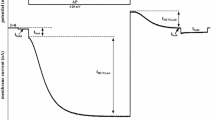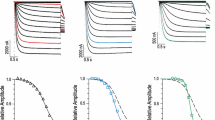Abstract
The activation kinetics of the endogenous Ca2+-activated Cl− current (I Cl,Ca) from Xenopus oocytes was investigated in excised “giant” membrane patches with voltage and Ca2+ concentration jumps performed by the photolytic cleavage of the chelator DM-nitrophen. Currents generated by photolytic Ca2+ concentration jumps begin with a lag phase followed by an exponential rising phase. Both phases show little voltage dependence but are Ca2+-dependent. The lag phase decreases from about 10 ms after a small Ca2+ concentration jump (0.1 μM) to less than 1 ms after a saturating concentration jump (55 μM). The rate constant of the rising phase is half-maximal at about 5 μM. At saturating Ca2+ concentrations, the rate constant is 400 to 500 s−1. The Ca2+ dependence of the stationary current can be described by the Hill equation with n=2.3 and K 0.5=0.5 μM. The amplitude of the stationary current decreases after the excision of the membrane patch with t 1/2≈5 min (run-down). The activation kinetics of the current elicited by a Ca2+ concentration jump is not affected by the run-down phenomenon. At low Ca2+ concentration (0.3 μM), voltage jumps induce a slowly activating current with voltage-independent time-course. Activation is preceded by an initial transient of about 1-ms duration. At saturating Ca2+ levels (1 mM), the initial transient decays to a stationary current. The transient can be explained by a voltage-dependent inactivation process. The experimental data reported here can be described by a linear five-state reaction model with two sequential voltage-dependent Ca2+-binding steps, followed by a voltage-independent rate-limiting transition to the open and a voltage-dependent transition to a closed, inactivated state.










Similar content being viewed by others
References
Arreola J, Melvin JE, Begenisich T (1996) Activation of calcium-dependent chloride channels in rat parotid acinar cells. J Gen Physiol 108:35–47
Boton R, Dascal N, Gillo B, Lass Y (1989) Two calcium-activated chloride conductances in Xenopus laevis oocytes permeabilized with the ionophore A23187. J Physiol (Lond) 408:511–534
Barish ME (1983) A transient calcium-dependent chloride current in immature Xenopus oocyte. J Physiol (Lond) 342:309–325
Currie KPM, Wooton JF, Scott RH (1995) Activation of Ca2+-dependent Cl− currents in cultured rat sensory neurones by flash photolysis of DM-nitrophen. J Physiol (Lond) 482:291–307
Dascal N (1987) The use of Xenopus oocytes for the study of ion channels. CRC Crit Rev Biochem 22:317–387
Ellis-Davies GCR, Kaplan JH, Barsotti RJ (1996) Laser photolysis of caged calcium: rates of calcium release by nitrophenyl-EGTA and DM-nitrophen. Biophys J 70:1006–1016
Evans MG, Marty A (1986) Calcium-dependent chloride currents in isolated cells from rat lacrimal glands. J Physiol (Lond) 378:437–460
Goldman DE (1943) Potential, impedance, and rectification in membranes. J Gen Physiol 27:37–60
Goldin AL (1992) Maintenance of Xenopus laevis and oocyte injection. Methods Enzymol 207:266–279
Gomez-Hernandez J-M, Stühmer W, Parekh AB (1997) Calcium dependence and distribution of calcium activated chloride channels in Xenopus oocytes. J Physiol (Lond) 502:569–574
Hartzell HC (1996) Activation of different Cl− currents in Xenopus oocytes by Ca2+ liberated from stores and by capacitive Ca2+influx. J Gen Physiol 108:157–175
Hilgemann DW (1989) Giant excised cardiac sarcolemmal membrane patches: sodium and sodium-calcium exchange currents. Pflugers Arch 415:247–249
Hilgemann DW (1995) The giant membrane patch. In: Sackmann B, Neher E (eds) Single channel recording. Plenum, New York, pp 307–327
Kaplan JH, Ellis-Davies GCR (1988) Photolabile chelators for the rapid photorelease of divalent cations. Proc Natl Acad Sci U S A 85:6571–6575
Kappl M, Hartung K (1996) Rapid charge translocation by the Na+-Ca2+ exchanger after a Ca2+ concentration jump. Biophys J 71:2473–2485
Koumi S, Ryoichi S, Aramaki Machaca T (1994) Characterization of the calcium-activated chloride channel in isolated guinea-pig hepatocytes. J Gen Physiol 104:357–373
Kuruma A, Hartzell HC (2000) Bimodal control of a Ca2+-activated Cl− channel by different Ca2+ signals. J Gen Physiol 115:59–80
Latorre RA (1994) Molecular workings of large conductance (maxi) Ca2+-activated K+ channels. In: Peracchia C (ed) Handbook of membrane channels. Academic, San Diego, pp 79–102
Läuger P (1991) Electrogenic ion pumps. Sinauer Associates, Sunderland, MA, USA
Miledi R, Parker I (1984) Chloride current induced by injection of calcium into Xenopus oocytes. J Physiol (Lond) 357:173–183
Neely A, Olcese R, Wei X, Birnbaumer L, Stefani E (1994) Ca2+ dependent inactivation of a cloned cardiac Ca2+ channel α 1 subunit (α 1c) expressed in Xenopus oocytes. Biophys J 66:1895–1903
Piper AS, Large WA (2003) Multiple conductance states of single Ca2+-activated Cl− channels in rabbit pulmonary artery smooth muscle cells. J Physiol (Lond) 547:181–196
Qu Z, Hartzell HC (2000) Anion permeation in Ca2+-activated Cl− channels. J Gen Physiol 116:825–844
Takahashi T, Neher E, Sackmann B (1987) Rat brain serotonin receptors in Xenopus oocytes are coupled by intracellular calcium to endogeneous channels. Proc Natl Acad Sci U S A 84:5063–5067
Weinreich F, Wood PG, Riordan JR, Nagel G (1997) Direct action of genistein on CFTR. Pflugers Arch 434:484–491
Zygmunt AC (1994) Intracellular calcium activates a chloride current in canine ventricular myocytes. Am J Physiol 267:H1984–H1995
Author information
Authors and Affiliations
Corresponding author
Rights and permissions
About this article
Cite this article
Haase, A., Hartung, K. Activation and inactivation kinetics of a Ca2+-activated Cl- current: photolytic Ca2+ concentration and voltage jump experiments. Pflugers Arch - Eur J Physiol 452, 81–90 (2006). https://doi.org/10.1007/s00424-005-0004-y
Received:
Accepted:
Published:
Issue Date:
DOI: https://doi.org/10.1007/s00424-005-0004-y




